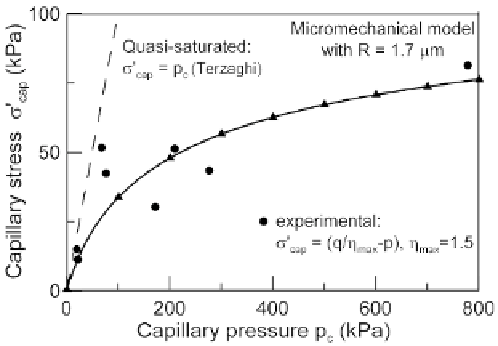Geoscience Reference
In-Depth Information
maximum strength criterion. In the case of the triaxial tests on Perafita sand, this
leads to the function σ
'
cap
(
p
c
), as shown in Figure 6.16. The “experimental” values of
σ
'
cap
are derived from
σ
'
cap_exp
=
p'
- (
p - p
a
) = (
q/
η
max
) - (
p - p
a
)
[6.24]
The same approach is used to interpret the results of the small strain tests, with
the same value of parameter
R
in the case of the unsaturated specimens.
Figure 6.16.
Comparison between the values at failure derived from the triaxial tests
and the results of the micromechanical model
6.5.1.
Interpretation of large strain triaxial tests
The stress paths for the different tests are shown in Figure 6.17, taking into
account the effective vertical stress σ'
v
. For the quasi-saturated specimens, the slope
of the maximum strength criterion is η
max
≈ 1.5. With a characteristic dimension
R
equal to 1.7 µm (
d
= 3.4 µm), the paths of the unsaturated specimens also finish near
the same maximum strength criterion as the quasi-saturated tests. The shape of the
stress paths is rather that of drained specimens, especially for the driest samples
corresponding to the largest values of σ
'
cap
, and, therefore, of σ'
v
. The reason is the
fact that the capillary pressure remains constant under these conditions, since the
sample strains are small. On the other hand, for the wettest specimens (under low
suction values), the behavior is that of overconsolidated specimens. For some of the
driest specimens, the localization of deformations, already mentioned, results in
premature brittle failure of the specimens, which do not reach perfect plasticity.

Search WWH ::

Custom Search